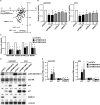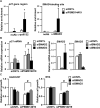Targeting PSMD14 inhibits melanoma growth through SMAD3 stabilization
- PMID: 33154524
- PMCID: PMC7644625
- DOI: 10.1038/s41598-020-76373-y
Targeting PSMD14 inhibits melanoma growth through SMAD3 stabilization
Abstract
Although melanoma therapy is improved by novel molecular targeted reagents, including vemurafenib, aberrant proliferation and early metastasis remain obstacles for melanoma; therefore, novel target molecules for melanoma need to be identified. In this study, we focused on deubiquitinating enzymes, which regulate protein stability through ubiquitin-proteasome systems, and identified 26S proteasome non-ATPase regulatory subunit 14 (PSMD14) as a molecule related to melanoma growth using siRNA library screening. Similar to a previous report, PSMD14 knockdown strongly induced p21 expression and inhibited RB phosphorylation in melanoma. After in silico analysis, TGF-β signaling was identified as a negatively correlated gene set with PSMD14 expression. Although TGF-β signaling is also related to the invasive phenotype of melanoma, PSMD14 knockdown suppressed melanoma migration and reduced SLUG expression, suggesting that targeting PSMD14 suppresses both growth and migration. Furthermore, SMAD3 expression increased in nucleus and SMAD3 degradation was delayed after PSMD14 knockdown. Thus, our present study suggests that targeting PSMD14 can inhibit melanoma growth and migration through either SMAD3 accumulation or SLUG reduction, respectively.
Conflict of interest statement
The authors declare no competing interests.
Figures




References
Publication types
MeSH terms
Substances
LinkOut - more resources
Full Text Sources
Medical
Research Materials

